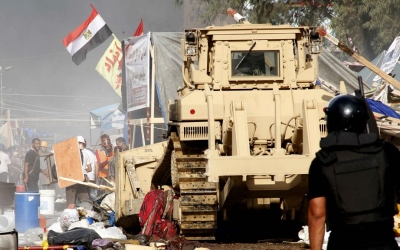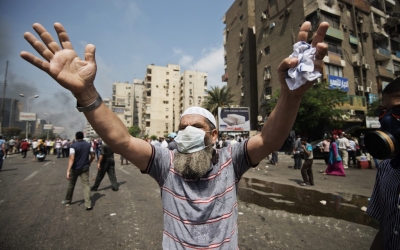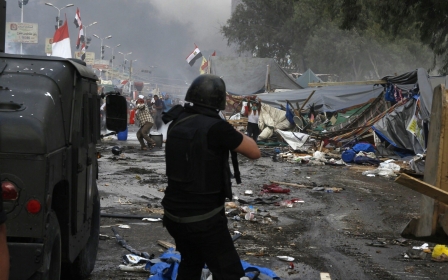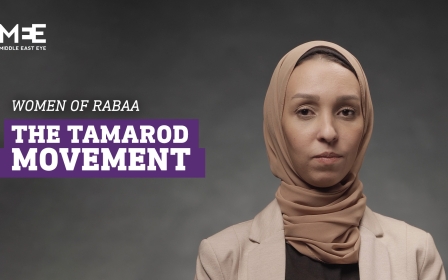Rabaa massacre: Sisi 'concealed' official report implicating government in mass killings
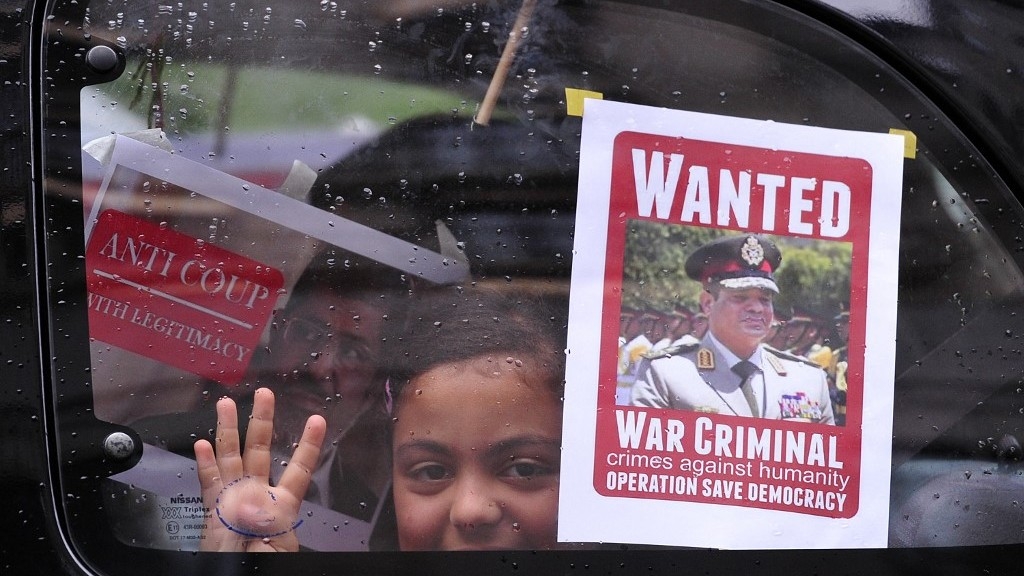
The government of President Abdel Fattah el-Sisi has for nine years withheld the publication of an official report on the Rabaa massacre that implicated Egyptian authorities in the mass killing of hundreds of protesters on 14 August 2013, according to a rights group.
The report, which has been leaked to the Egyptian Initiative for Personal Rights (EIPR), accused security forces of "indiscriminate and disproportionate use of live ammunition" and concluded that the government had excluded less violent alternatives to disperse the sit-in.
"The largest number of Rabaa victims were innocent civilians who were most likely peaceful demonstrators,” the report, which was concluded in late 2014, read. “Those who took up arms and terrorised the citizens managed to escape from Rabaa Square."
In August 2013, tens of thousands had gathered in Cairo's Rabaa al-Adawiya Square to demand the return of former president Mohamed Morsi, who had been deposed by his defence minister and current Egyptian leader Sisi in a coup a month and a half earlier.
Egyptian soldiers and police officers killed at least 900 people as they forcibly dispersed a protest camp in the square on 14 August.
New MEE newsletter: Jerusalem Dispatch
Sign up to get the latest insights and analysis on Israel-Palestine, alongside Turkey Unpacked and other MEE newsletters
Despite heavy visual documentation of the killings by Egyptian activists, journalists and rights groups, to date no one responsible for the deaths has been prosecuted by the authorities.
The leaked report had recommended carrying out an official investigation that would include the testimonies of victims and officials.
"This file must be reopened by a committee composed of investigating judges who order the summoning of witnesses who witnessed these events and officials,” it read, as quoted by EIPR.
“This is to enable the public to know the truth, preserve national unity, and prevent this political division from turning into a societal rift that threatens the unity of the state. The wounds suffered by all victims need healing."
'A mockery of justice'
The report was drafted by a panel of senior Egyptian judges tasked by the government to conduct a probe into the events. The judges, however, were not mandated to listen to victims, eyewitnesses or government officials.
The committee was chaired by the late judge Fouad Abdel Moneim Riad, an academic and former international judge at the International Criminal Court for the former Yugoslavia, and included Judge Iskandar Ghattas, the former assistant minister of justice, and Judge Omar Marawan, who is currently serving as justice minister in Egypt.
The committee’s mandate, according to a decree by interim president Adly Mansour in December 2013, did not include summoning officials, filing accusations, or referring facts to trial.
Instead, it relied on available evidence from secondary sources as well as interviews and analysis. Yet it remains the only official report related to the dispersal of the Rabaa square protest, which Human Rights Watch has described as “the largest mass killing in Egypt’s modern history.”
The fact-finding panel spent a year documenting the violence that took place since the 30 June protests agains Morsi, the 3 July coup led by then defence minister Sisi, and the violent crackdown on the anti-Sisi protests that erupted following Morsi’s ousting.
Riad and members of his committee met with Sisi on 23 November 2014 to submit the final version of their report, which has yet to be officially made public.
Three days after its meeting with Sisi, the committee held its final press conference to announce the report’s findings. According to Riad, the report contained 766 pages, in addition to 11,000 pages of appendices, attachments, and documents. It also had CDs containing photos, and videos with evidence.
However, the committee published only an executive summary of 57 pages, including only seven pages on the dispersal of Rabaa.
In a Facebook post before Riad’s death in 2020, he wrote that the report “remains concealed”.
The executive summary, unlike the full report, matched the official version adopted by the state since the events, and which was used as the basis for the criminal prosecution of 739 protesters. The mass trial was denounced by Amnesty International as “disgraceful” and “a mockery of justice”, as not a single police officer or government official had been brought to justice.
A bloody dispersal
The official version described the sit-in as an armed gathering and claimed that the security forces had given time to protesters to voluntarily leave through a designated safe corridor.
It also claimed that participants in the sit-in had fired live bullets at the forces, which resulted in deaths and injuries, leading the security forces to respond with live ammunition, in accordance with the principles of necessity and proportionality, until they took control of the square.
The executive summary and the official version also said the security forces found 51 firearms and “a quantity of ammunition” at the sit-in.
The leaked report also includes the previously unpublished official Rabaa dispersal plan.
The plan, submitted to the committee by the interior ministry, comprised 10 expected scenarios, including the possibility of live fire against the security forces or using women, children and other peaceful protesters as “human shields.”
Yet the official version claimed that the security forces were surprised by live ammunition being used against them and that they had to respond accordingly, causing the large amount of deaths. However, the panel of judges concluded that the firing of live ammunition by the security forces was indiscriminate and disproportionate.
"Did the dispersal force maintain proportionality in firing in terms of the type of weapon, the intensity of fire, and the results of dispersing the gathering, including deaths and injuries, and the destruction of public and private property?" the report raised the question in its analysis.
The report said a number of technical criteria needs to be examined to assess whether the security forces had used excessive force, including the number of victims, the number of armed men, the number of security forces, the type of their weapons, and the range of overcrowding of personnel and the timing and duration of the alarm.
At the end of the analysis, the report concluded that, “The law enforcement agencies, even if they had a legitimate reason to disperse the assembly, and the necessity of using firearms and had maintained the qualitative proportionality between the weapons used, they had failed to estimate the number of victims when responding to the sources of fire coming from the armed elements.
"The fact-finding committee does not doubt that it was possible to end the Rabaa rally without all this blood being spilled," it said.
Human Rights Watch has characterised the mass killing of protesters in Rabaa and Nahda squares in 2013 as possible crimes against humanity.
Under international law, perpetrators of crimes against humanity could face prosecution before the International Criminal Court if domestic legal systems fail to bring them to justice. But since Egypt is not party to the Rome statute of the ICC, and has not provided an ad hoc declaration of consent for the court to exercise jurisdiction in this case, the suspects must be referred to the court through the UN Security Council or can face trials in other countries using universal jurisdiction.
Lawyers, however, have yet to succeed in their attempts to prosecute high-ranking members of the post-coup government internationally.
Middle East Eye delivers independent and unrivalled coverage and analysis of the Middle East, North Africa and beyond. To learn more about republishing this content and the associated fees, please fill out this form. More about MEE can be found here.


